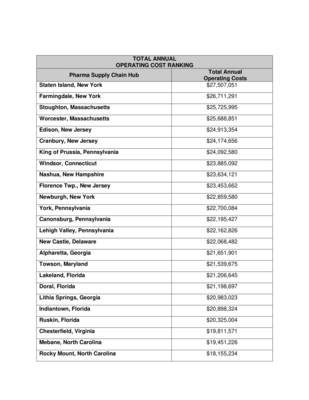Reshoring Trend
The Covid-19 pandemic has done much to expose the vulnerabilities in our nation’s pharmaceutical supply chain, according to The Boyd Co., Inc., the Princeton, NJ-based corporate site selection firm. The rush to ship limited inventories of test kits, personal protection items, plasma and drugs has been challenging due to longstanding supply chain weaknesses in single sourcing and an over-reliance on extended offshore suppliers.
Estimates are that some 80 percent of active ingredients used in U.S. pharmaceutical production are sourced overseas, principally from China and India. The pandemic has been a painful wakeup call that our pharmaceutical supply chain is far too risky and reliant on distant nations.
As this reshoring trend back to the U.S. plays out – prompted by the pandemic and now being encouraged by new bipartisan carrot and stick legislation being crafted in Washington, DC – the commercial real estate industry and service providers are positioning for a new wave of supply chain facilities designed to serve the pharmaceutical and biotechnology industries.
Cold Chain Expansion
This new wave of logistics investment comes after hundreds of millions of square feet of distribution and fulfillment space have already been constructed along the densely populated U.S. East Coast fueled by the booming ecommerce industry led by firms like Amazon. Geographically, the majority of this new pharma-related supply chain activity is also focusing on the East Coast which houses most of the nation’s major pharmaceutical production hubs, such as Boston, New Jersey, Philadelphia, Raleigh/Durham and South Florida.
These new pharma supply chain projects are part of the nation’s cold chain – temperature-controlled, refrigerated facilities designed to keep products like drugs as well as food fresh and safe. Pharmaceutical and biotechnology firms are developing a wide range of new products that rely on cold storage throughout the entire supply chain. Biologics – drugs and medicines developed from living organisms, including vaccines, blood and viruses – are all driving new cold storage demands.
Also fueling expansion in the cold chain is the growing popularity of online pharmaceutical deliveries like Amazon’s pharma delivery service – PillPack – and similar drugs-by-mail programs of insurance firms like Aetna, United Healthcare and Humana.
Another major catalyst will be the unprecedented volume of doses associated with the highly awaited COVID-19 vaccine when that becomes available and hits the nation’s supply chain.
Boyd estimates that as much as 125 million sq. ft. of cold chain supply space will be required to meet new demands, much coming from pharma. One takeaway of the COVID-19 crisis is that policymakers in Washington, DC, are now viewing drug security much in the same light as our nation’s strategic petroleum reserve.
A good example of new cold chain growth is third-party logistics supplier DHL which is expanding its pharma network by 40 percent and investing some $150 million in new facilities in major areas of pharma and medical devices production, most recently in Raleigh, North Carolina’s Research Triangle.
Top 25 Pharma Supply Chain Hubs – Ranked by Operating Costs
The 25 cities named in Boyd’s Pharma Supply Chain Report were selected based on their proximity to regional pharmaceutical production hubs – generally 2 hours or less – transportation infrastructure, real estate inventories for new supply chain development, life science labor market access and logistics considerations.
Annual operating costs in Boyd’s report range from a high of $27.5 million in Staten Island, New York, to a low of $18.1 million in Rocky Mount, North Carolina. The cost differential between the New York location (a state with a corporate income tax rate of 6.5 percent) and North Carolina (a state with the nation’s lowest corporate income tax rate at 2.5 percent) is $9.4 million, a significant differential of 34.2 percent.
North Carolina houses the top two-ranked pharma supply chain locations – Rocky Mount and Mebane. The state’s biopharma industry is extensive, comprised of over 600 companies with more than 60,000 employees with specializations in pharma manufacturing, health informatics, medical devices and crop genetic engineering. Research Triangle Park (RTP), the largest research park in the U.S., is situated between Mebane and Rocky Mount. Its 7,000 acres house over 200 of the world’s leading pharma and biotech companies.
Boyd’s cost analysis includes all major geographically-variable factors critical to the corporate site selection process such as labor, real estate, construction, taxes, utilities scaled to a 175,000 sq. ft. pharma supply chain center employing 225 workers.
Growing pressures for price controls on prescription drugs along with tax, trade and regulatory uncertainties associated with the 2020 presidential election are all causing a heightened focus on operating costs in the pharmaceutical industry.
About Boyd
Founded in 1975, The Boyd Company, Inc., provides independent location counsel to leading North American and overseas corporations. The Princeton, NJ-based site selection firm periodically charts cost structures in high growth industries and industries in transition like pharmaceuticals and med tech. Boyd clients both in and out of the pharma industry include GlaxoSmithKline, Philips, Mayne Pharma, Dendreon, Boeing, Dell, PepsiCo, JP Morgan Chase, UPS and others.


